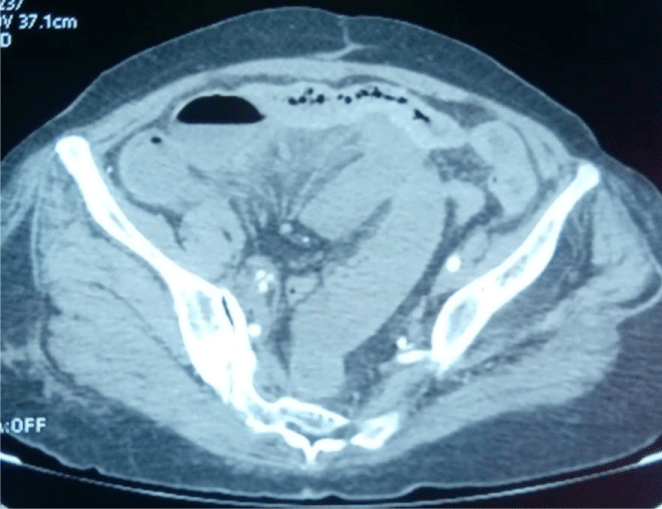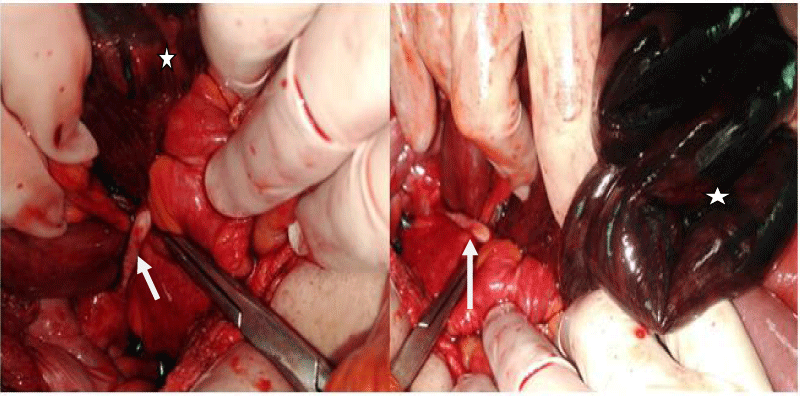Global Journal of Medical and Clinical Clinical Image
Strangulated internal hernia underneath right external iliac artery: A case report
Abdelilah Elbakouri*, A Lamnaouer, M Bouali, K Elhattabi, F Bensardi and A Fadil
Cite this as
Elbakouri A, Lamnaouer A, Bouali M, Elhattabi K, Bensardi F, et al. (2022) Strangulated internal hernia underneath right external iliac artery: A case report. Glob J Medical Clin Case Rep 9(3): 046-048. DOI: 10.17352/2455-5282.000158Copyright License
© 2022 Elbakouri A, et al. This is an open-access article distributed under the terms of the Creative Commons Attribution License, which permits unrestricted use, distribution, and reproduction in any medium, provided the original author and source are credited.Small bowel obstruction following internal herniation under the external iliac artery after total hysterectomy with pelvic lymph node dissection is a rare entity. We describe a case of strangulated internal hernia between the right external iliac artery and the psoas muscle as a late complication after 3 years of radical hysterectomy with pelvic lymphadenectomy. Retroperitoneal closure may be an appropriate procedure to effectively prevent such internal hernias. the emergency CT scan was used to diagnose a flange occlusion in the context of the situation. it was only during surgical exploration that the cause of the occlusion was revealed as an internal hernia. a resection of the ischemic bowel was performed with retroperitonealization of the artery.
Introduction
Pelvic lymphadenectomy is a standard procedure in the surgical treatment of certain cancers, such as prostate, ovarian and cervical cancer [1]. With several complications, however, internal herniation under a skeletonized artery is a very rare complication after PLND [2].
The first publication of an iatrogenic internal hernia of the small intestine underneath the iliac artery was reported by Guba et al in 1978, 4 months after pelvic lymph node dissection and irradiation in a patient with testicular cancer [3].
To date, no study has reported a precise prevalence of internal herniation resulting from a vascular structure. It is regarded as extremely rare [4].
Case presentation
A 68-year-old woman, hypertensive on treatment, with a history of endometrial cancer 3 years ago, who had a radical open hysterectomy with bilateral salpingo-oophorectomy, pelvic and para-aortic lymphadenectomy; presented to our hospital complaining of right lower abdominal pain, vomiting, and inability to pass gas or stool for the past 4 days.
Physical examination revealed a pulse rate of 107 beats/min and blood pressure of 155/74 mmHg, with right lower abdominal tenderness and moderate abdominal distension. Laboratory tests found a white blood cell count of 16,570/mm3 (with 89.6% neutrophils) and a C-reactive protein level (53.7 mg/dL).
The abdominal computerized tomography finding was the presence of mechanical looped bowel obstruction in the right iliac fossa, with moderate peritoneal effusion that may be related probably to an internal hernia or a flange given the context Figure 1.
A careful reading of the CT images was not completed as we decided to proceed with urgent surgery as soon as possible, given the diagnosis of small bowel obstruction and the patient’s deteriorated general condition.
The surgical exploration by median laparotomy objectified a peritoneal effusion made of intestinal suffering liquid, and 70 cm of necrotic bowel at 40 cm of the ileocecal junction herniated into the gap between the right external iliac artery and the psoas muscle. The incarcerated The small bowel was carefully liberated by a maneuver of pressing and retracting from the orifice, showing a black color nonviable. during the operation, the patient presented a hemodynamic instability, which forced us to make a resection of the necrotic part with an ileostomy. And to prevent the recurrence of the hernia, the artery was retroperitonealized Figures 2,3.
The patient developed postoperative functional renal failure which was controlled and then was discharged from the hospital 15 days after surgery in good general condition.
Discussion
Postoperative small bowel obstruction (SBO) due to flange and/or adhesions represents a frequent and costly complication of abdominal surgery with 61.75% of acute bowel obstructions [5]. Our patient was also considered preoperatively as an SBO by the flange.
Internal hernia is a relatively rare cause of small bowel obstruction following surgery, with an attributable rate of 5.8%. More than 90% of internal hernias are caused by a natural orifice, which, according to Ghahremani’s classification system can be separated into 6 main groups: paraduodenal hernias, hernias through the foramen of Winslow, transmesenteric hernias, pericecal hernias, intersigmoid hernias, and paravesical hernias. An internal hernia produced by a vascular structure is surely an exceptionally rare type of hernia with no epidemiological data on its prevalence [6].
To our knowledge, the present case is the first case in Morocco after radical hysterectomy with bilateral salpingo-oophorectomy, pelvic and para-aortic lymphadenectomy for endometrial cancer, which is even rare in the world. Only 8 cases of internal hernia beneath the EIA after PLND in English-language literature have been reported [4].
Given its uncommonness, our patient was first diagnosed as SBO on flange given the clinical picture, and the physical examination, and even after a CT scan, the doubt persisted.
In general, evoking the diagnosis of small bowel internal hernia is a difficult clinical decision. However, the diagnosis of an internal hernia under the external iliac artery by CT scan may be more feasible than that of other kinds of internal hernias [7].
Although pelvic lymph node dissection (PLND) is a gold standard for many cancer operations, there are no formal guidelines regarding whether or not to close the peritoneum.
As this situation is a rare but potentially fatal complication after PLND, the need for retroperitonealization after pelvic lymphadenectomy must be debated [8].
In everyday life, a good knowledge of the existence of this complication, despite its rarity, make it possible to prevent it, and also to differentiate it intraoperatively from a flange that has the same appearance, and avoid any inattentive section of the external iliac artery.
Conclusion
Internal hernia underneath the external iliac artery is an extremely rare and urgent complication that can be life-threatening. It should be the concern of every surgeon when faced with an occlusive syndrome after PLND.
- Ninomiya S, Amano S, Ogawa T, Ueda Y, Shiraishi N, Inomata M, Shimoda K. Internal hernia beneath the left external iliac artery after robotic-assisted laparoscopic prostatectomy with extended pelvic lymph node dissection: a case report. Surg Case Rep. 2019 Mar 28;5(1):49. doi: 10.1186/s40792-019-0609-6. PMID: 30923950; PMCID: PMC6439070.
- Kim KM, Kim CH, Cho MK, Jeong YY, Kim YH, Choi HS, Kim SM. A strangulated internal hernia behind the external iliac artery after a laparoscopic pelvic lymphadenectomy. Surg Laparosc Endosc Percutan Tech. 2008 Aug;18(4):417-9. doi: 10.1097/SLE.0b013e318172fca2. PMID: 18716548.
- Guba AM Jr, Lough F, Collins GJ, Feaster M, Rich NM. Iatrogenic internal hernia involving the iliac artery. Ann Surg. 1978 Jul;188(1):49-52. doi: 10.1097/00000658-197807000-00008. PMID: 666377; PMCID: PMC1396649.
- Zhang Z, Hu G, Ye M, Zhang Y, Tao F. A strangulated internal hernia beneath the left external iliac artery after radical hysterectomy with laparoscopic pelvic lymphadenectomy: a case report and literature review. BMC Surg. 2021 May 31;21(1):273. doi: 10.1186/s12893-021-01249-5. PMID: 34059048; PMCID: PMC8166092.
- Mayers MA. Internal abdominal hernias. In: Mayers MA, ed. Dynamic Radiology of the Abdomen. 5th ed. New York, NY: Springer-Verlag; 2000:711–748.
- Ghahremani GG. Abdominal and pelvic hernias. In: Gore RM, Levine MS, eds. Textbook of Gastrointestinal Radiology. 2nd ed. Philadelphia, PA: Saunders; 1994.
- Viktorin-Baier P, Randazzo M, Medugno C, John H. Internal Hernia Underneath an Elongated External Iliac Artery: A Complication After Extended Pelvic Lymphadenectomy and Robotic-assisted Laparoscopic Prostatectomy. Urol Case Rep. 2016 Jun 4;8:9-11. doi: 10.1016/j.eucr.2016.05.003. PMID: 27313985; PMCID: PMC4906033.
- Abu-Rustum NR, Yashar CM, Bean S, Bradley K, Campos SM, Chon HS, Chu C, Cohn D, Crispens MA, Damast S, Fisher CM, Frederick P, Gaffney DK, Giuntoli R, Han E, Huh WK, Lurain Iii JR, Mariani A, Mutch D, Nagel C, Nekhlyudov L, Fader AN, Remmenga SW, Reynolds RK, Sisodia R, Tillmanns T, Ueda S, Urban R, Wyse E, McMillian NR, Motter AD. NCCN Guidelines Insights: Cervical Cancer, Version 1.2020. J Natl Compr Canc Netw. 2020 Jun;18(6):660-666. doi: 10.6004/jnccn.2020.0027. PMID: 32502976.

Article Alerts
Subscribe to our articles alerts and stay tuned.
 This work is licensed under a Creative Commons Attribution 4.0 International License.
This work is licensed under a Creative Commons Attribution 4.0 International License.



 Save to Mendeley
Save to Mendeley
